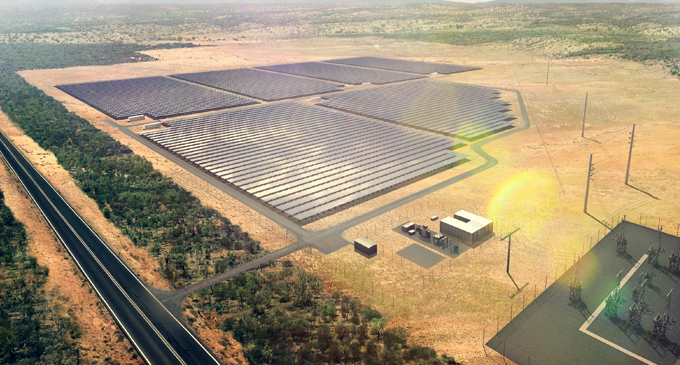Australia is getting its first grid-connected solar and storage plant, which will be built in the northern Queensland town of Lakeland and connected to Ergon Energy network. Conergy is developing the US$42 million project, with the BHP Billiton resource company joining in via a Knowledge Sharing Partnership (KSP).
Others involved in the KSP are the Australian Renewable Energy Agency (ARENA), Ergon Energy and Origin Energy.
The project is set to begin construction in September. The plans include installing a 13MW solar array with 41,440 solar panels and a 1.4MW/5.3MWh Conergy ‘CHESS’ storage on 60 hectares of land. Conergy aims to complete the project by April 2017.
According to ARENA, what makes this utility-scale solar and battery storage project unique is that it will be connected to Ergon Energy network and will test a concept known as ‘islanding.’
“This project is aiming to be the first in the world to test a concept known as ‘islanding’ from the main electricity grid. The local town of Lakeland will be powered solely by solar and batteries for several hours during these tests,” said ARENA CEO, Ivor Frischknecht.
We're partnering on Australia’s 1st solar plant w/battery storage connected to a major grid https://t.co/9KpREdD5E5 pic.twitter.com/Sev7dXHRdQ
— BHP (@bhp) August 25, 2016
The idea is “the Holy Grail of the global renewable energy industry,” said Conergy managing director David McCallum, adding that it will create a consistent power supply in an area that often experiences outages.
“This is an exciting opportunity to combine the latest developments in solar technology with utility-scale battery storage to feed consistent, quality power into the existing electricity grid particularly in fringe-of-grid locations,” McCallum said.
BHP Billiton expressed great interest in the project, while stressing that over 35% of its greenhouse gas emissions come from generating electricity.
“The Lakeland Solar and Storage Project is a great way to explore technologies that could accelerate our transition to a lower emissions business,” the company said in a press release. “The battery storage component of the project is particularly important to us. Because energy from the sun isn’t always available, it’s essential to be able to capture and store solar energy to ensure consistent access to power.”
We're building the 1st #solar PV + battery storage project in #APAC! Read more on @pv_tech: https://t.co/CBVEcCiQeY pic.twitter.com/ldXcl97qEY
— blueleaf energy (@blueleafenergy) August 23, 2016
BHP said there are similarities between Lakeland’s ‘fringe of the grid’ location (area that often experiences power outages) to some of their own Asset locations in South Australia. “Studying this area will allow us to learn how similar technology could benefit our operations,” the company said.
The project also received financial help from ARENA, which gave a grant worth AU$17.4 million. On top of that, the German bank NORD/LB contributed a 15-year non-recourse financing facility and Norton Rose Fulbright provided legal advice.
If the development is successful, it could prove that solar can easily replace some of the more traditional non-renewable energy sources, said President of Conergy APAC, Alexander Lenz.
“Solar farms have traditionally been built . . . as a peak shaving solution. But with our solar-plus-storage solution, intermittency is smoothened out, providing a dependable and stable power supply that is capable of dispatching energy 24/7,” Lenz noted.
“The implications of this concept, of solar as a baseload solution are tremendous and even disruptive: not only can solar now replace some traditional baseload technologies but, with the supply of more predictable and dependable energy blocks during the day and night, solar energy has now become even more tradable.”

